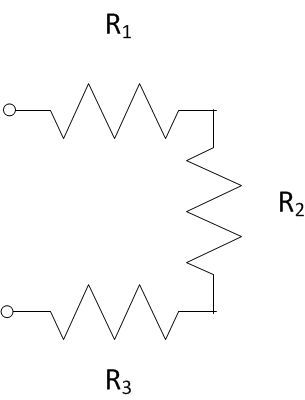Circuit Analysis Shortcuts
Proof of the Series Resistance Formula
Learn It!
Pre-Requisite Knowledge
To understand this section, you need to know the
following concepts:
Goal
Derive the series resistance formula
Using Ohm's Law and Kirchoff's circuit laws, derive the formula for the equivalent resistance of multiple resistors in series.

For the case of three differently valued resistors labeled \(R_1,R_2,R_3\), prove that the equivalent
resistance of all of them together is \(R_{eq}=R_1+R_2+R_3\)
Part 1
Proving the formula
\(
\begin{align}
V_1&=I R_1 \\
V_2&=I R_2 \\
V_3&=I R_3
\end{align}
\)
Ohm's Law for each resistor. Take note that the voltages across each resistor are not in general the same.
All three resistors are in series, so they all share a single current, the unsubscripted \(I\)
\(V=V_1+V_2+V_3\)
Apply KVL. The voltages across all the elements add up to the terminal voltage, \(V\) with no subscript.
\(V= I R_1 +I R_2 +I R_3\)
Substitute individual ohm's law equations into KVL equation.
We do this to get a single equation relating the total voltage to the full current.
\(V= I \underbrace{(R_1 + R_2 + R_3)}_{R_{eq}} \)
Factor out the current \(I\). Now current is in only one place, so our equation looks suspiciously like Ohm's law again, but with a different \(R\).
\(V= I ( R_{eq}) \)
The quantity in the parentheses is a factor relating total current to total voltage, so it is the equivalent resistance. We win!
★
\(R_{eq}=R_1 + R_2 + R_3\)
We have proven the series resistance formula for three resistors.
Extending this proof to an arbitrary number of resistors doesn't change it much, and results in the general
formula in the formula in the course notes
and the shorter derivation found there.


